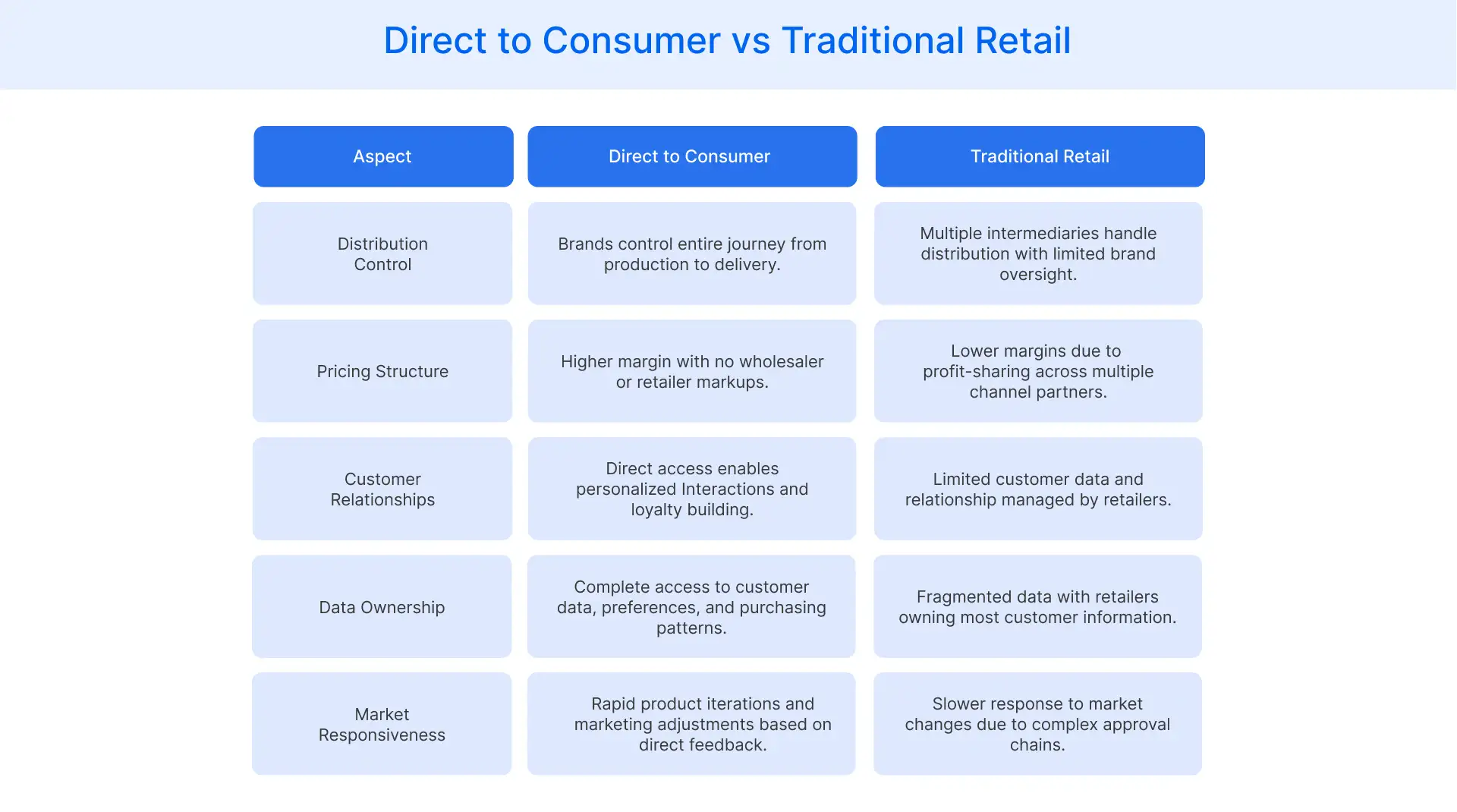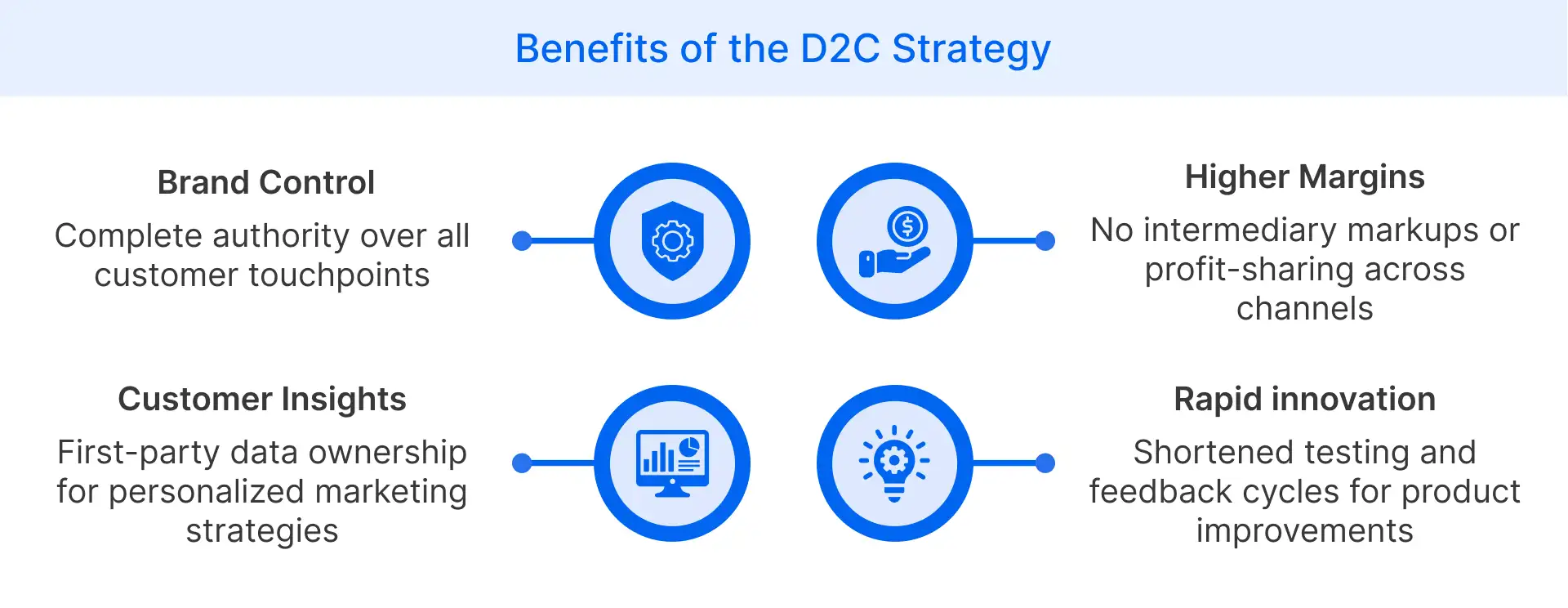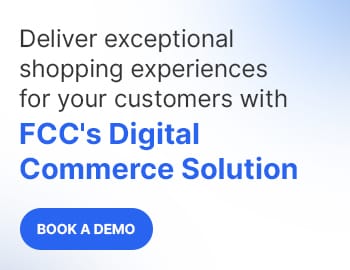Table of Contents
- What is Direct-to-Consumer?
- Direct-to-Consumer vs Traditional Retail
- What are the Key Characteristics of DTC?
- What are Some Examples of Successful D2C Brands?
- Benefits of a D2C Business Model
- Best Practices to Run the D2C Business Model
- Conclusion
What is Direct-to-Consumer?
Direct-to-Consumer represents a progressive shift in how manufacturers bring products to market. In the DTC model, brands create, market, sell, and ship their products directly to end users without relying on third-party online retailers or intermediaries.
Retailers establish immediate connections with customers through their own channels, such as ecommerce websites, social media platforms like Facebook and Instagram, and branded physical stores. The rise of Direct-to-Consumer corresponds with digital transformation, allowing brands to leverage technology for an exceptional customer experience.
This approach provides companies with unprecedented access to consumer data (purchase history), enabling personalized marketing and product development while maintaining control over pricing and brand integrity throughout the customer journey.
Direct-to-Consumer vs Traditional Retail
While traditional retail relies on complex distribution networks with multiple handoffs, the DTC strategy streamlines the entire process. This restructuring impacts everything from profit margins to how quickly you can respond to market changes.
Here are the key differences between these models:

What are the Key Characteristics of DTC?
The Direct-to-Consumer model distinguishes itself through six fundamental characteristics that enable brands to maintain control while establishing stronger customer connections with loyal customers for higher operational efficiency.
- Direct Line of Communication with Customers: Brands communicate with end-users through their own channels, eliminating intermediaries, to create authentic relationships and gather unfiltered feedback for continuous improvement.
- Control over the Customer Experience: You determine every aspect of the customer journey from online storefront navigation to packaging design, ensuring consistent brand messaging and quality during the checkout process.
- Digital Marketing Focus: DTC companies utilize social media, blog content, and digital advertising to directly reach their target audiences, often building communities centered around their products and values with the help of influencers.
- Data-Driven Decision Making: With direct access to customer data, you gain actionable insights about purchasing behavior, preferences, and demographic information to drive the development of product lines and consumer marketing strategies.
- Cost-Effectiveness: By eliminating wholesale markups and retailer margins, Direct-to-Consumer brands can offer lower prices compared to brick and mortar stores while maintaining healthier profit margins or reinvesting in product quality.
- Agility and Flexibility: The streamlined structure of DTC operations enables quick pivots in strategy, rapid product launches, and the immediate implementation of customer feedback, all without complex approval processes for small businesses.
What are Some Examples of Successful D2C Brands?
The direct-to-consumer (DTC) ecosystem features both digital-native DTC brands that have disrupted traditional industries and established brands that have pivoted to embrace direct customer relationships.
Pioneering D2C Brands
These innovative brands built their ecommerce business model around direct customer relationships from inception, challenging industry norms and creating new standards for consumer experience.
- Warby Parker (Eyewear): Transforming the way people purchase eyewear, Warby Parker introduced a home try-on program that allows customers to receive five frame options for testing before making a purchase. Their vertically integrated model disrupted the monopolistic eyewear industry by offering designer-quality frames at $95 instead of $200+ through traditional channels.
- Dollar Shave Club (Personal Care): With their viral marketing launch and subscription model, Dollar Shave Club captured significant market share from established razor giants. You receive quality razors delivered monthly at a fraction of retail prices while the company maintains consistent revenue through recurring subscriptions rather than one-time purchases.
- Casper (Mattresses): Transforming the mattress shopping experience, Casper eliminated awkward showroom testing with their “100 nights risk-free” trial. The company compressed premium mattresses into shippable boxes and developed proprietary foam technology, allowing you to purchase confidently online while saving 50-70% compared to traditional mattress retailers.
- Allbirds (Footwear): Combining environmental sustainability with direct distribution, Allbirds created shoes from merino wool and sustainable materials. You experience transparent pricing without retail markups while supporting eco-friendly practices, as the company reinvests margin advantages into superior materials rather than traditional distribution and advertising costs.
Traditional Brands Adopting D2C
Recognizing the advantages of direct customer relationships, these established companies have strategically expanded their business models to incorporate Direct-to-Consumer channels.
- Adidas: Implementing an aggressive “DTC-focused” growth strategy, Adidas has expanded its e-commerce platform and exclusive brand stores worldwide. You gain access to limited-edition releases and personalized products through their mobile app and online store.
- Kraft Heinz: Launching direct-to-consumer platforms like “Heinz to Home” during the pandemic, Kraft Heinz now offers product bundles and exclusive items unavailable in retail stores. You can purchase themed boxes and staple products delivered directly to your door, while the company collects valuable customer data that informs new product development and marketing strategies.
What are the Benefits of a D2C Business Model?
The Direct-to-Consumer approach offers distinct competitive advantages that enable brands to thrive in today’s digital marketplace.
- Complete Brand Control: You maintain authority over how customers perceive and interact with your brand across all touchpoints. This unified approach eliminates inconsistent messaging from third-party retailers, allows you to craft distinctive unboxing experiences, and ensures product presentation aligns perfectly with your brand vision.
- Enhanced Profit Margins: By eliminating intermediaries, you capture the full margin typically distributed across the supply chain. This financial advantage enables you to reinvest in product innovation, lower consumer prices for a competitive edge, or simply enhance profitability.
- Valuable Customer Insights: You collect first-party data directly from consumers about their browsing habits, purchase patterns, and product preferences. This information goldmine enables you to create detailed customer personas, identify opportunities for upselling, and tailor messaging for specific market segments.
- Accelerated Product Innovation: Your direct relationship with customers creates shorter feedback loops for product testing and refinement. You can quickly gauge consumer response to new offerings, implement A/B testing for product variations, and integrate customer suggestions into development cycles.

Best Practices to Run the D2C Business Model
While Direct-to-Consumer offers numerous advantages, it also presents unique obstacles that require strategic solutions.
- Strategic Customer Acquisition: Combat rising digital advertising costs by diversifying your marketing approach across organic social media, content marketing, and referral programs. You should invest in SEO optimization to drive organic traffic, establish strategic partnerships with complementary brands, and create loyalty programs that incentivize repeat purchases.
- Optimized Fulfillment Systems: Manage logistics complexity by implementing inventory management software that provides real-time visibility across all storage locations. You can partner with third-party logistics providers that specialize in e-commerce fulfillment, strategically position inventory across multiple warehouses to reduce shipping times, and develop contingency plans for handling seasonal demand fluctuations.
- Sustainable Growth Planning: Scale your Direct-to-Consumer operation by securing appropriate funding through venture capital, strategic partnerships, or revenue-based financing. You should develop automated systems that maintain customer experience quality during expansion, implement gradual geographic rollout strategies, and consider marketplace partnerships that supplement direct sales without sacrificing control.
- Enhanced Customer Support: Build robust service capabilities by implementing omnichannel support systems across email, chat, phone, and social media. You should create comprehensive self-service knowledge bases, develop proactive communication protocols, and establish clear policies for returns and exchanges.
Conclusion
The Direct-to-Consumer model represents a fundamental shift in how brands connect with their audiences in today’s digital economy. You gain unprecedented control over customer relationships while potentially increasing profitability through disintermediation.
When evaluating DTC for your business, consider your industry dynamics, your audience's digital savviness, and your operational capabilities. Success requires striking a balance between the challenges of customer acquisition and fulfillment logistics, and the benefits of brand control and data ownership.
FAQ
Focus on customer acquisition cost relative to lifetime value, aiming for an LTV at least three times your CAC. Track average order value, purchase frequency, and retention rates. Monitor conversion rates at each funnel stage and net promoter score.
Develop an e-commerce presence while maintaining wholesale partnerships. Build expertise in digital marketing and direct fulfillment gradually. Create online-only products to minimize channel conflict and maximize efficiency. Communicate transparently with retail partners about your evolving distribution strategy.
True DTC brands manufacture their own products and sell directly to customers without intermediaries. E-commerce simply describes the online transaction method, while Direct-to-Consumer encompasses your entire business model, including production, distribution, and customer relationships.
You need a mobile-optimized e-commerce platform, secure payment processing, and CRM software for tracking customer interactions. Implement inventory management systems to enhance stock visibility and utilize analytics tools to gain a deeper understanding of consumer behavior throughout the purchasing journey.

